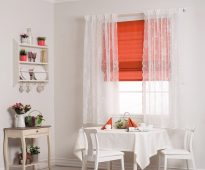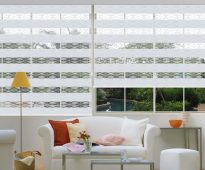Description of curtains - what is it, what is different from curtains and curtains
What is the difference between curtains, curtains, curtains and curtains? Where did the tradition come from that windows should be decorated with long pieces of fabric? The answers to these questions are in history. From where all modern models of these curtains, curtains and curtains came to us.
Curtains are called any fabric that closes the window or doorway. However, these fabrics are different in terms of material and style.
Content
- 1 Brief history of various models of curtains
- 2 The differences between curtains and drapes
- 3 Curtain and Curtain Differences
- 4 The combination of curtains, drapes and curtains in modern interiors
- 5 Recommendations for choosing curtains
- 6 Video on how to choose the right curtains
- 7 Curtains in the interior - 50 photos
Brief history of various models of curtains
One of the ancestors of curtains can be called the invention of the first people. They curtained the passageways into their caves with the help of the large and heavy skins of dead animals. They did this in order to show the advantage of the inhabitants of this cave over others, or to hide from the light of the day - is unknown. But the tradition to cover the holes in the wall with various materials remained with people.
The window is not only a source of light, but also part of the interior of the room.
Depending on how the fashion and technical arrangement changed, the curtains themselves also changed on the windows. Therefore, nowadays a modern person would prefer to go to the store and buy there fabrics for the house, which came to us from Byzantium, Greece or France, and would not go looking for more loot to close the hole in the wall.
In modern interiors, window curtains play two roles - functional and decorative
Curtains
The word "curtains" came from France during the predominance of the Baroque culture in society - the tendency to excess. At this time, the curtains consisted of long and dense cloths of fabrics on which various ornaments and designs were embroidered or painted. Now this technique is also used in modern interiors on the curtains Jacquard, but not so active.
Heavy curtains - one of the most characteristic baroque elements. Made of their elite fabrics and combined with curtains
Curtains
Curtains - these are light monochromatic curtains in the interior, which practically do not delay the sunlight, but rather dissipate it, unlike curtains. Due to its light structure, this type of curtains has become very popular in the antique interior. They seem to create a balance between the detailed and active environment of the room and the calm decor of the window.
Curtain fabric in the antique interior is often flax
The opposite of ancient style is the new Scandinavian. He seeks simplicity and space creation. However, the curtain - this is a fairly inexpensive version of the curtains, which can be installed in the hall, kitchen or bedroom. Because a thick catalog of colors and textures makes it possible to choose a suitable shade that would emphasize home comfort.
Scandinavian style is imbued with the spirit of minimalism, so the curtains here should be from a simple translucent fabric without any decor
Portieres
Portieres practically does not differ from curtains. Except for the fabric.If for the manufacture of curtains mainly use heavy and dense materials, which is the main focus in the interior, the curtains on the contrary. They adapt to the existing home environment and can be represented by various materials: silk, velvet, linen, cotton, etc.
In most cases, the curtains are called rather massive curtains of high-density fabric and opacity
Curtains
Under the curtain refers to all other types of fabric that can frame windows. Most often they are decorative. They are presented in the form of a short curtain for a kitchen window or even an ultra-thin curtain for framing a canopy bed. They carry almost no functional value.
Curtains are often a simplified version of this or that type of curtain.
Most often curtains are used to decorate windows in village styles.
The differences between curtains and drapes
Based on the history, we can say that the curtains appeared much earlier than the drapes. The latter became widespread when expensive Oriental fabrics such as silk began to be imported to Europe. Then the transition from one type of interior to another began. The royal bulky embroidered curtains were replaced by thin, flowing silk. And in order to somehow keep him from the winds, the fabrics began to be collected with the help of special cords.
Portieres look massive and majestic
In the interior of a modern room, you can often see curtains complementing a roll or Roman curtain
Curtains drapery - it is not only silk, but velvet, cotton and all other types of fabric that can be gathered on the sides. Also, a distinctive feature of curtains is that they can be supplemented with elements such as ruffles, pelmets, eyelets, monograms, tassels, fringe, to give the windows more solemnity and high prices.
Curtains and drapes unites their main purpose - to prevent light from entering the room
Curtain and Curtain Differences
If the curtains and curtains can still be confused, the curtains are the design element of the window, which cannot be compared with the others because of its variety of forms. They can be long and short, very light and vice versa heavy, transparent, with or without a pattern, made in the form of a fabric or mesh.
For curtains important cornice on which it is fixed. These two elements are always matched and decorated with beautiful decor.
Curtains are often hung on a stringed eaves or even on a strong rope.
Also, if we take the facts from history, the curtains can be compared with the village curtains on the windows. They were simple and made from natural materials, without unnecessary decorative elements. Such fabrics, for convenience and economy, were cut into two parts and hung as short curtains in order to cover the windows from the rays of the sun and prying eyes.
Quite often curtains can be found on the doorway.
The combination of curtains, drapes and curtains in modern interiors
For a long time curtains, drapes and curtains used together: the more expensive fabric was on the windows, the richer the house was considered. Therefore, unnecessarily bright and bulky designs in the style of "excess" - it was in the order of things.
Nowadays, such combinations are found in classic interiors.
But as time went on, preferences and tastes of people changed. And now, from an active baroque, the public has become more inclined to more simplistic forms. By removing the curtains with the grommets, you could get quieter, even curtains with a translucent curtain.
For a room with a lack of lighting, light curtains are better suited
Or vice versa, if you leave the curtains, but remove all other unnecessary elements, you can give the interior a completely different mood. It all depends on the room where the curtains will be located.
Now and at all all these three elements (curtains, curtains and curtains) can exist separately and not depend on each other. For example, for the kitchen more suitable short curtains in the style of a retro cafe.
Short curtains in the kitchen in retro style
In the living room it is better to leave the mood that the French once tried to create, namely, the solemnity and wealth that can be achieved with the help of curtains.
Exquisite French style living room with drapes to the floor
Curtains, as an independent element for the design of the window, has undergone the greatest changes. In the market of manufacturers you can see a lot of options. Therefore, to choose the most suitable curtains for the bedroom will be easy. The main thing is that they are as dense as possible and do not let the morning sunlight through.
The design of the curtains must match the overall interior of the bedroom.
Recommendations for choosing curtains
- First of all it is necessary to pay attention to the quality of the fabric, and not to the design of the curtains.
- All fabrics consist of an unequal ratio of synthetic and natural threads. And depending on their quantity, the fabric can pass air well or badly, keep its shape and collect dust. Therefore, it is first necessary to determine the functional characteristics of the fabric for the windows in each room, and then select the design.
Translucent curtains expand the space and create an intricate visual effect.
- It is necessary to decide on what function the curtains perform. They should attract attention to themselves or, on the contrary, shade details in the interior.
- The texture and pattern of the canvas on the windows should be associated with the interior elements. These can be pillows on the couch, candlesticks, paintings, etc.
In the bedroom curtains are usually associated with textiles on the bed.
- In different rooms, the fabric for curtains can show its color differently depending on the location of the windows and the brightness of the lighting. Therefore, it is recommended to take a few curtains and see them directly in the room, and then make a choice in favor of one of the options.
- The back of the curtain often burns out in the sun due to the structure of the fabric, so it is better for him to use the lining.
The curtain is lined with a contrasting color.
- When buying textiles, and not ready-made curtains, it is important to correctly calculate the consumption of fabric on the width and length of the window.
- Depending on the nature of the fabric, the length of the curtain is determined. If the canvas is soft, it is better to make curtains, the lower part of which will lie on the floor. Thick curtains, keeping their shape, should be strictly to the floor and not a centimeter more.
The height of the walls in the room can be changed visually using the length of the curtains.
- Using a universal formula: if the interior is light with a minimum of decor, then it is better to use light curtains, the strict classical style is emphasized by the brilliance of the curtain, while the modern one requires even and strict forms.
- There should be only one active element on the curtains: color, pattern, cornice, etc.
The ornament on the curtains should overlap with any decorative element in the interior of the room.
Video on how to choose the right curtains
Curtains in the interior - 50 photos
 Roman curtains: design in the interior of the kitchen, photo
Roman curtains: design in the interior of the kitchen, photo
 About roller blinds Zebra for plastic windows
About roller blinds Zebra for plastic windows






